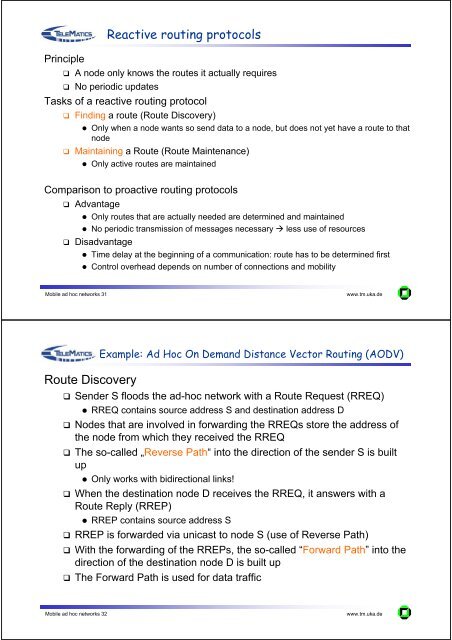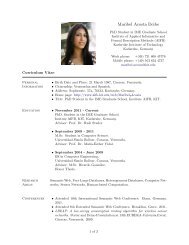Mobile ad hoc networks (MANET)
Mobile ad hoc networks (MANET)
Mobile ad hoc networks (MANET)
You also want an ePaper? Increase the reach of your titles
YUMPU automatically turns print PDFs into web optimized ePapers that Google loves.
Principle<br />
Reactive routing protocols<br />
A node only knows the routes it actually requires<br />
No periodic updates<br />
Tasks of a reactive routing protocol<br />
Finding a route (Route Discovery)<br />
Only when a node wants so send data to a node, but does not yet have a route to that<br />
node<br />
Maintaining a Route (Route Maintenance)<br />
Only active routes are maintained<br />
Comparison to proactive routing protocols<br />
Advantage<br />
Only routes that are actually needed are determined and maintained<br />
No periodic transmission of messages necessary less use of resources<br />
Dis<strong>ad</strong>vantage<br />
Time delay at the beginning of a communication: route has to be determined first<br />
Control overhe<strong>ad</strong> depends on number of connections and mobility<br />
<strong>Mobile</strong> <strong>ad</strong> <strong>hoc</strong> <strong>networks</strong> 31<br />
www.tm.uka.de<br />
Route Discovery<br />
Example: Ad Hoc On Demand Distance Vector Routing (AODV)<br />
Sender S floods the <strong>ad</strong>-<strong>hoc</strong> network with a Route Request (RREQ)<br />
RREQ contains source <strong>ad</strong>dress S and destination <strong>ad</strong>dress D<br />
Nodes that are involved in forwarding the RREQs store the <strong>ad</strong>dress of<br />
the node from which they received the RREQ<br />
The so-called „Reverse Path“ into the direction of the sender S is built<br />
up<br />
Only works with bidirectional links!<br />
When the destination node D receives the RREQ, it answers with a<br />
Route Reply (RREP)<br />
RREP contains source <strong>ad</strong>dress S<br />
RREP is forwarded via unicast to node S (use of Reverse Path)<br />
With the forwarding of the RREPs, the so-called “Forward Path” into the<br />
direction of the destination node D is built up<br />
The Forward Path is used for data traffic<br />
<strong>Mobile</strong> <strong>ad</strong> <strong>hoc</strong> <strong>networks</strong> 32<br />
www.tm.uka.de




